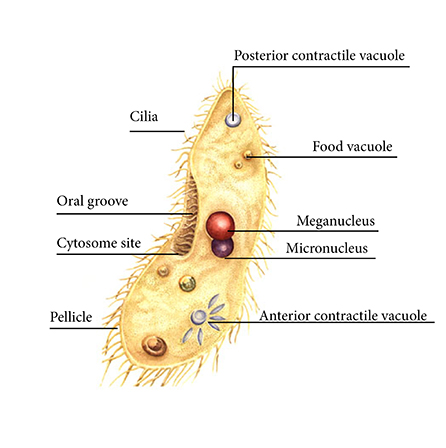Marvellous micro-organisms 2: Paramecium

Natural history illustration involves painting plants, animals, and other wonders of the natural world. Micro-organisms fall under this umbrella, and although extremely small they are still deserving of our attention (and illustrations). Last week I looked at the Ameoba. This week it’s the turn of the Paramecium.
Introduction to the Paramecium
Like the amoeba, the Paramecium is an independent, free-living unicellular organism. Paramecium can be found in abundance in stagnant water where they feed off tiny bits of plant, and bacteria. The largest are only 1/2mm long, so to examine them a microscope is required.
They’re part of a phylum called Ciliophora which refers to the cilia, or tiny “hairs”, found all over their bodies. Each row of cilia beats in a wave-like metachronal rhythm. They are used to propel the animal through water. As these rows of hairs spiral around the body, the Paramecium spins as it swims.

The cilia protrude from a flexible yet stiff cell membrane, called a pellicle.
Anatomy of the Paramecium
At the top of the diagram you can see the contractile vacuole. There’s one at either end of the paramecium; unlike amoeba, paramecium have a consistent body shape. These vacuoles make sure there’s not too much nor too little water inside the animal’s cell membrane. Spreading out from these vacuoles are radiating canals which provide paths to the vacoule.
A paramecium body is full of cytoplasm which maintains organelles.
Paramecium feeding
Paramecium eat through an oral groove, which directs food into the paramecium’s mouth (or cytosome). Food is brought to this area by ciliary action; once at the mouth it’s packaged into food vacuoles. Here, the food is digested as it circulates in the animal’s body. See this process in action below.
Nucleus of the Paramecium
The macronucleus programs and runs the paramecium; it controls digestion, growth, movement, and other cell functions.
The micronucleus is separate and controls reproduction. Paramecium can reproduce asexually ( up to two or three times a day) by dividing with binary fission. Less usually, they reproduce sexually through conjugation. This involves fusing material from two micronuclei, which undergo meiosis before three of the four resulting nucleii disintegrate. The remaining nucleus undergoes mitosis. Daughter nuclei join before the cells split apart. The original macronucleus disintegrates, and is replaced with a newly formed one. After this, asexual reproduction normally occurs.
Paramecium can defend themselves!
Paramecium can defend themselves with the use of trychocysts, similar in function to those found in the jellyfish and sea anenomes. These trychocysts are needle llike projections that can be ejected out from the cell mebrane. Below are some trychocsyts in action:
More can be found at 101Science’s site where I did some research.
Next week: the Euglena!
Although I love micro-organisms I am certainly no expert, so please get in touch if you spot any errors, I’d be more than happy to fix them.

